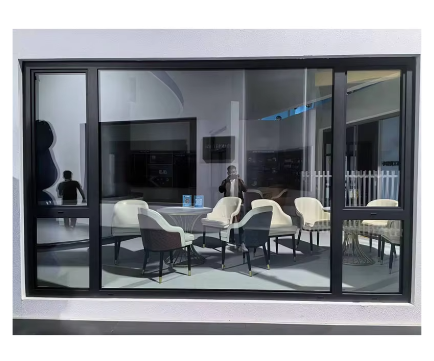Key Differences Between Sliding and Casement Windows
Operation Mechanism: How They Open and Close
Knowing the basics of how sliding and casement windows work makes all the difference when picking the right fit for any given room. Sliders run along horizontal tracks so they just glide back and forth without taking up extra room inside or outside. That's why they're great for tight spots where there's no room to spare since they don't stick out at all. Casement windows tell a different story though. These ones hinge on one side and swing outward like doors, giving much more airflow through the space. The catch? They need some breathing room outside to function properly. Weather wise, sliding windows tend to hold up better in stormy conditions because of their solid frames. Meanwhile, casement models usually seal tighter against rain and wind, which helps keep heating and cooling costs down over time. Some folks even notice a significant difference in drafts during winter months depending on which type they install.
Design and Space Requirements
How sliding and casement windows are designed affects both how they look and how useful they are in any given space. Sliding windows have this sleek modern appearance and can span pretty large areas too. That's why they work so well when someone wants to take in big views or create that contemporary feel in a home. These windows basically fill up those wide walls without getting in the way of the view outside. On the other hand, casement windows tend to look more traditional but need quite a bit of room around them to actually open properly. Sometimes this means having to position them carefully within a room's layout. The type of window chosen really does shape where furniture goes because of the space it takes up and how it opens. When deciding between these options, people usually find themselves weighing what looks good against what actually works in terms of available space. Some homeowners even end up compromising based on budget constraints or existing architectural features.
Pros and Cons Comparison
Sliding Windows: Space Efficiency vs. Limited Ventilation
Sliding windows really save space, especially when dealing with small rooms or cramped corners where traditional outward opening windows just won't work. The way they slide horizontally means people don't have to worry about clearing extra room around them for operation. But there's a downside too. These windows typically only open about halfway, so they let in less fresh air than something like a casement window that swings wide open. Studies keep showing how important proper ventilation actually is. Take a look at any home with better airflow and chances are the indoor air quality improves quite a bit. This makes a real difference in day to day comfort levels and overall health in the long run.
Casement Windows: Superior Seal vs. Mechanical Complexity
Casement windows have a great reputation when it comes to sealing out drafts, which means less air leaks through and better energy efficiency overall. People living in areas where keeping energy bills low matters a lot find these windows particularly useful since they cut down on both heating and cooling expenses. The downside though? These windows come with some complicated moving parts that tend to wear out or need fixing after a few years, so there's usually more money spent on repairs down the road. Most window specialists will point toward casement models if someone lives somewhere cold or windy where good insulation counts for something. Still worth considering despite the extra work involved in maintaining them properly over time.
Energy Efficiency and Ventilation Performance
Air-Tight Sealing in Casement Windows
Casement windows stand out when it comes to saving energy because they seal really well against drafts. What makes them special is this kind of hook shaped lock system that actually pushes the window firmly into place against the frame, making sure no cold air gets in during winter months. Research indicates houses with these types of windows tend to be around 15 percent more efficient than ones with sliding options. But here's something worth remembering folks - all those great sealing properties only work if the installation was done right. If someone doesn't put in a casement window properly, then instead of keeping heat inside, it might just let it escape through gaps, completely wiping out whatever savings were supposed to happen.
Slider Window Air Leakage Risks
Sliding windows definitely have their perks but come with a downside too when it comes to air leakage because of how they're built around those tracks. The way these windows work naturally creates gaps that let cold or warm air sneak through, which means higher bills for heating and cooling throughout the year. Some studies suggest that up to twenty percent of our energy costs might actually be going out the window this way! Regular checks on those tracks and seals make all the difference though. Homeowners should look under the tracks where dust and dirt tend to collect over time, clean them out thoroughly, and check if the rubber seals still fit snugly against the frame. When done properly, this simple maintenance keeps homes warmer in winter and cooler in summer without wasting money on excess energy consumption month after month.
Maintenance and Security Considerations
Cleaning Accessibility Comparison
Sliding windows make cleaning much easier, especially from inside the house since they have sashes that move side to side instead of opening outward. The ability to slide these panes across means homeowners don't need to prop them wide open just to wipe down glass surfaces, something that matters a lot on second story windows where reaching out is tricky business. Casement windows tell a different story altogether though. Those with cranks tend to be harder work when it comes time for cleaning, particularly if mounted high up somewhere. Cleaning becomes less about convenience and more about wrestling with ladders and extension poles. Regular maintenance really does matter here too. Windows that stay cleaner longer won't collect grime buildup as fast, so there's less chance of water spots turning into permanent stains or seal damage from moisture getting trapped between frames.
Locking Systems and Break-In Resistance
In terms of security, casement windows tend to beat sliding ones because they come with those multi-point locking systems that really stand up to break-ins. Casement windows close so tightly that most burglars just skip over them since the locks are built right into the frame itself and pretty tough to get around. Sliding windows aren't completely insecure mind you, but without proper reinforcement they can actually become entry points for thieves who manage to lift the glass panels right off their tracks. Security pros always stress picking window styles that resist forced entry better, something homeowners should definitely keep in mind when upgrading their homes.
Cost Analysis and Ideal Applications
Upfront Costs vs. Long-Term Savings
Sliding windows tend to be cheaper at first glance than casement models, so they're pretty popular among folks watching their budgets. Homeowners looking to keep things affordable upfront especially gravitate toward these options during big projects such as building a house from scratch or doing major renovations. But here's the catch: even though sliding windows might seem like the better deal right now, casement windows actually end up saving money in the long run because they insulate much better. Casement windows really cut down on those monthly heating bills and air conditioning costs too, so what seems expensive initially could pay off after a few years. When picking out windows for any kind of construction work, it pays to look beyond just the sticker price. Think about all the hidden costs too installation fees, regular cleaning needs, plus those ongoing utility bills. Getting this whole picture straight helps anyone decide whether spending extra now will actually save cash later.
Best Use Cases: Egress Needs and Architectural Styles
Sliding windows work really well in modern houses that have those clean, simple designs. They just slot right into today's architectural trends without looking out of place. What makes them stand out is how their straight lines let people see outside without anything getting in the way, which definitely boosts the look of any contemporary interior space. Casement windows tell a different story though. These tend to fit better in older neighborhoods or when homeowners want big openings for fresh air and plenty of daylight coming through. Their traditional appearance matches up nicely with homes built in earlier times, giving good looks along with practical benefits. Building regulations sometimes dictate what kind of windows need to be installed for emergency exits, so checking local rules before making decisions matters quite a bit. Smart homeowners pick windows that look great while still meeting all the necessary safety requirements, because after all, nobody wants problems later on down the road.
FAQ
What are the main differences between sliding and casement windows?
The primary differences lie in their operation mechanisms, design aesthetics, energy efficiency, and ventilation. Sliding windows operate horizontally and offer modern aesthetics, while casement windows swing outward and provide strong sealing capabilities, making them energy-efficient.
Which window type is more energy-efficient?
Casement windows are generally more energy-efficient due to their superior air-tight sealing capabilities, which effectively reduce air leakage.
How do maintenance requirements differ between the two?
Sliding windows offer easier accessibility for cleaning due to their horizontal sliding feature, while casement windows might require more effort to clean due to their crank mechanism.
What security features do casement windows offer?
Casement windows typically have better security features with multi-point locking systems making them harder to compromise compared to sliding windows.

